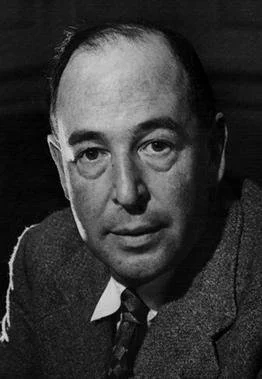Sermon for November 10, 2024 - Remembrance Sunday
Reepicheep
C. S. Lewis
For as long as I can remember, I have been captivated by the fantasy worlds of C.S. Lewis and J.R.R. Tolkien. The expansive worlds of Narnia and Middle-earth blend truth and myth together in ways that touch the heart and soul. I first discovered Narnia not through the books, but rather through the BBC television serials from the 1980’s that my family owned on VHS. From what I can remember, as a child I loved the adventures of the Pevensie children and the fantastical beasts, centaurs, Minotaurs, dwarves, and even talking animals that accompanied them on their adventures. Even Aslan’s sacrificial death echoed my Sunday School stories. I was drawn to the struggle between good and evil, and not just the children’s efforts to defeat the White Witch, but the struggles within themselves. As the middle child in my family, I identified with Edmund and his struggle to be noticed and included, which resulted in his deceptive actions. I also really liked the tiny mouse Reepicheep. What Reepicheep lacks in size, he more than makes up with his courage and his steadfast desire to make it to “Aslan’s Country.” What I didn’t know at the time but began to understand as I actually read the books, were the themes of love, sacrifice, redemption, and restoration that Lewis wove throughout the series and how his faith helped birth the story. As I would later find out, the creation story of Narnia shares many similarities with scripture.
My first encounter with Middle-earth would not be until much later in 2001 when I was sitting in the movie theater with my father preparing to watch The Fellowship of the Ring. To be fair, I was supposed to read The Hobbit for school at some point for summer reading, but I did not even pick it up. Instead, I stayed blissfully ignorant of the stories of Middle-earth, even though my father was obsessed, and I had no idea what to expect in this first movie. I remember when the movie ended and we are left wondering what will happen to Sam and Frodo, and the rest of the fellowship and whether they will be able to destroy the One Ring, the might Weapon of the Enemy, I looked over to my father and said desperately, “Well, what happens next?” He said, “I guess you will have to read the books to find out.” And so, I did. The next summer, I was in Moscow and St. Petersburg studying Russian language, culture, and literature, and about as far from home as one can get. While I very much enjoyed my time there, the Lord of the Rings series kept me company on my unexpected journey. These books were a tangible connection to my family back home and sustained me during those long nights away as both Frodo, Sam, and I were very, very far from home.
J. R. R. Tolkien
Lewis and Tolkien knew each other very well both as aspiring authors but also as professors at Oxford. Their literary group, the Inklings, was the forum in which these academics were able to share and support each other in their literary works, with each providing notes, and suggestions, and questions that helped to shape their stories. Their time together, and their Christian faith were not the only influences on these mighty works. Lewis and Tolkien shared something else in common that would affect their lives perhaps more than anything else, they were both soldiers who served in the British Expeditionary Forces fighting in the trenches of France. Their experiences of death and destruction in the Great War helped them to learn deep truths about faith, friendship, and heroism all of which are embodied by the characters and the narratives of their stories.
Both Tolkien and Lewis encountered the horrific realities of war in a post-industrial age, where hand to hand combat slowly gave way to new methods of mass destruction; machine guns, ever larger artillery, and the introduction of chemical warfare. In the trenches and barbed wire and mortars of the Great War, both men came face to face with the shadow side of human potentiality. On the one hand, the characters in their novels possess a great nobility: creatures endowed with a unique capacity for virtue, courage, and love. Indeed, a vital theme throughout is the sacred worth of the individual soul; in Middle-earth and in Narnia, every life is of immense consequence. On the other hand, their characters are deeply flawed individuals, capable of great evil, and in desperate need of divine grace to overcome their predicament. Both authors reflect the historic Christian tradition that we know to be true: human nature is a tragic mix of nobility and wretchedness. And that tragic mix was on full display in that war as enemies attempted to slaughter each other, and friends did all they could to support each other under the horrendous circumstances.
For Tolkien and Lewis, and for the typical British soldier, life in the trenches was akin to a nightmare. Life in these elaborate ditches was a quagmire of cold, wet, rat-infested squalor. The trenches were deep enough to protect a soldier and narrow enough to avoid direct hits from artillery fire. Every few yards a trench zig-zagged, to limit the damage from mortar or machine-gun attacks. Trench walls, supported by sandbags, were in a constant state of decay. Trench floors, even if covered with wooden duckboards, filled up with rain. Rats roamed about at will. Gorging themselves on human remains, some rats were the size of a cat. As bad as the water, mud, rats, roaches, and lice was the smell: the stench of decaying flesh, human and animal, untreated wounds, disease – any number of causes made death, and the smell of death, a constant presence for soldiers on the front line. This was their reality, firsthand experience of humanity’s destructive misuse of technology. Battlefields like that did not exist before. Much like the land of Mordor, they were surrounded by a land defiled, diseased beyond healing.
Coming face to face with the horrors of war compelled them to begin drafting their own stories. Confronted with the magnitude of death and destruction, Tolkien and Lewis decided to create worlds that reminded us that this is not the way it has to be. The world as they knew it could be better. There is still good in the world to confront evil. There is still light in the dark places when all other lights go out. In Narnia and in Middle-earth, even in the trenches, humans and creation are not forsaken, there is still hope.
And that is exactly what Jesus is saying to Martha as she and her sister come to terms with the death of their brother Lazarus. When faced with the death of their beloved brother, Mary and Martha plead with Jesus, lamenting his absence that surely could have saved Lazarus from death. And it is in this acute moment of despair that Jesus reminds the sisters that death is an end, but not the end, and therefore the world as we know it and experience it, is not all there is either. The violence and death we inflict on each other does not have to be this way. There is still hope. The human potential for good is deeply imbedded within us and is intrinsically intertwined with our potential to disfigure and destroy the world. This hope of life in God is not just a hope for some distant future, Jesus tells us that it is also now. We are called to be agents of love, peace, and reconciliation now, all of which are markers of the Kingdom of God.
We gather today and tomorrow to remember, so that we never forget. We remember and never forget that the Great War did not end all wars. We remember and never forget the terrible toll that war extracts. Lewis and Tolkien wrote their novels to remember, and remind us that we are indeed capable of terrible things, as we continue to see it play out in Gaza, Lebanon, the West Bank, Ukraine, Sudan, and everywhere else marred by war. And they also remind us that whether you are mouse, or a hobbit, courage and goodness lie within all of us because even the smallest person can change the course of the future. Remember, and never forget that we too are called to be agents of peace and live our lives walking in the footsteps of Christ as reflections of God’s light and love in this broken, but redeemable world.




